/*
假定输入的字符串中只包含字母和*号。
编写函数,实现:
除了字符串前导和尾部的*号之外,将串中其他*号全部删除。
在编写函数时,不得使用C语言提供的字符串函数。
例如,若字符串中的内容为****A*BC*DEF*G*******
删除后,字符串中的内容则应当是****ABCDEFG******
*/
#include <stdio.h>
#include <stdlib.h>
#include <string.h>
void fun(char *a) {
/**ERROR******/
int i=0;
char *t = a, * f = a;
char *q = a;
while (*t)
t++;
t--;
while (*t == ‘*‘)
t--;
while (*f == ‘*‘)
f++;
/***ERROR***/
while (q <f) {
a[i] = *q;
q++;
i++;
}
while (q < t) {
/***ERROR**/
if (*q != ‘*‘) {
a[i] = *q;
i++;
}
q++;
}
while (*q) {
a[i] = *q;
i++;
q++;
}
/**ERROR**/
a[i] = ‘\0‘;
}
int main() {
char s[81];
printf("Entre a string:\n");
gets_s(s);
/**ERROR**/
fun(s);
printf("The sting after deleted:\n");
puts(s);
system("pause");
return 0;
}
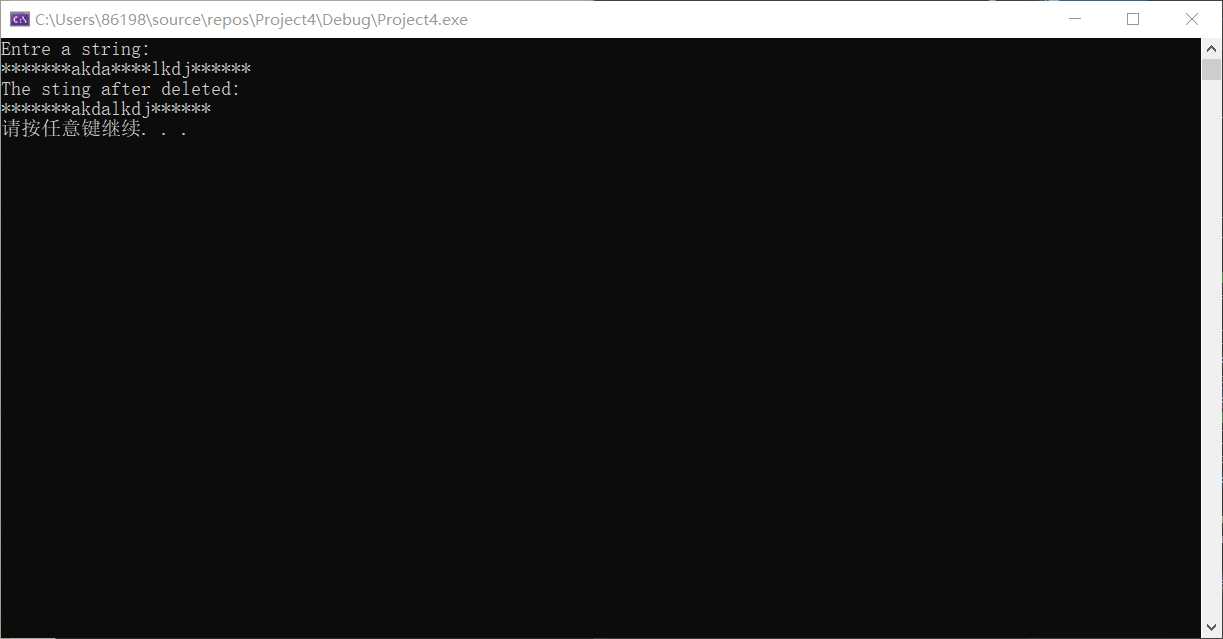
/* 假定输入的字符串中只包含字母和*号。 编写函数,实现: 除了字符串前导的*号之外,将串中其他*号全部删除。 在编写函数时,不得使用C语言提供的字符串函数。 例如,若字符串中的内容为****A*BC*DEF*G******* 删除后,字符串中的内容则应当是****ABCDEFG */ #include <string.h> #include <stdio.h> #include <stdlib.h> void fun(char *a) { /*****ERROR********/ int i=0; char *p = a; /****ERROR***/ while (*p && *p == ‘*‘) { a[i] = *p; i++; p++; } while (*p) { /******ERROR*******/ if (*p!= ‘*‘) { a[i] = *p; i++; } p++; } /******ERROR*******/ a[i] = ‘\0‘; } int main() { char s[81]; printf("Enter a string :\n"); gets_s(s); /***ERROR******/ fun(s); printf("The string after deleted:\n"); puts(s); system("pause"); return 0; }
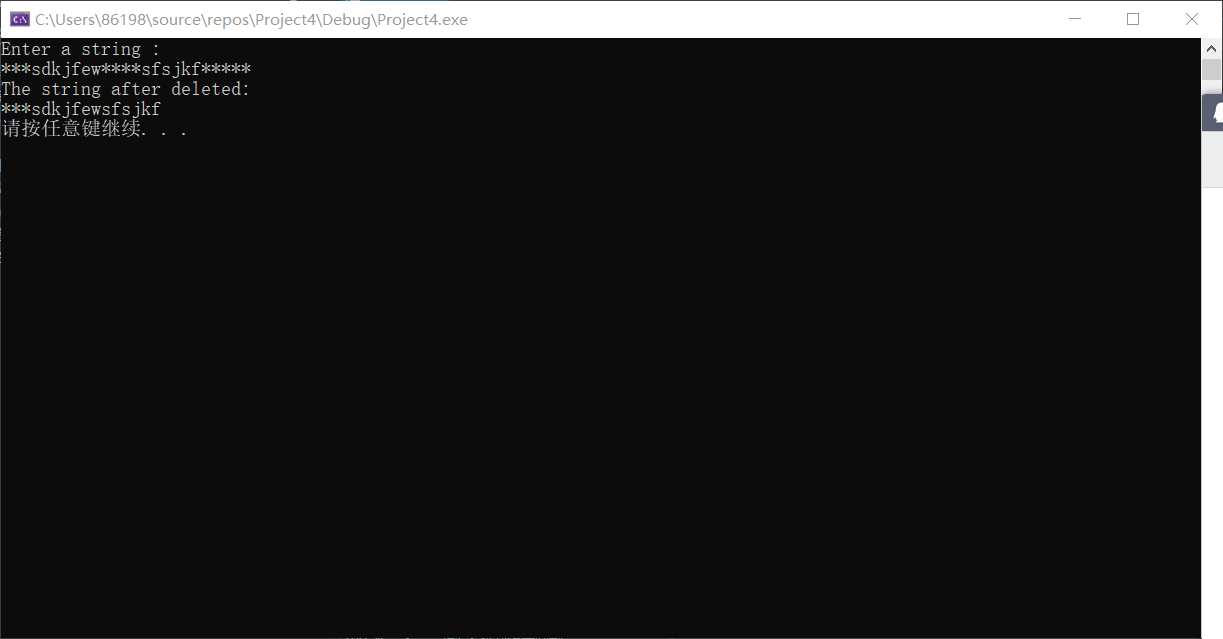
// 练习:使用选择法对字符串按字典序排序
#include <stdio.h>
#include <string.h>
#include <stdlib.h>
void selectSort(char str[][20], int n); // 函数声明,形参str是二维数组名
int main() {
char name[][20] = { "John", "Alex", "Joseph", "Taylor", "George" };
int i;
printf("输出初始名单:\n");
for (i = 0; i < 5; i++)
printf("%s\n", name[i]);
selectSort(name, 5); // 调用选择法对name数组中的字符串排序
printf("按字典序输出名单:\n");
for (i = 0; i < 5; i++)
printf("%s\n", name[i]);
system("pause");
return 0;
}
// 函数定义
// 函数功能描述:使用选择法对二维数组str中的n个字符串按字典序排序
void selectSort(char str[][20], int n) {
int i, j, k;
char m[20];
for (i = 0; i < n - 1; i++) {
k = i;
for (j = i + 1; j < n; j++)
if (strcmp(str[j], str[k]) < 0)
k = j;
if (k != i) {
strcpy(m, str[i]);
strcpy(str[i], str[k]);
strcpy(str[k], m);
}
}
}
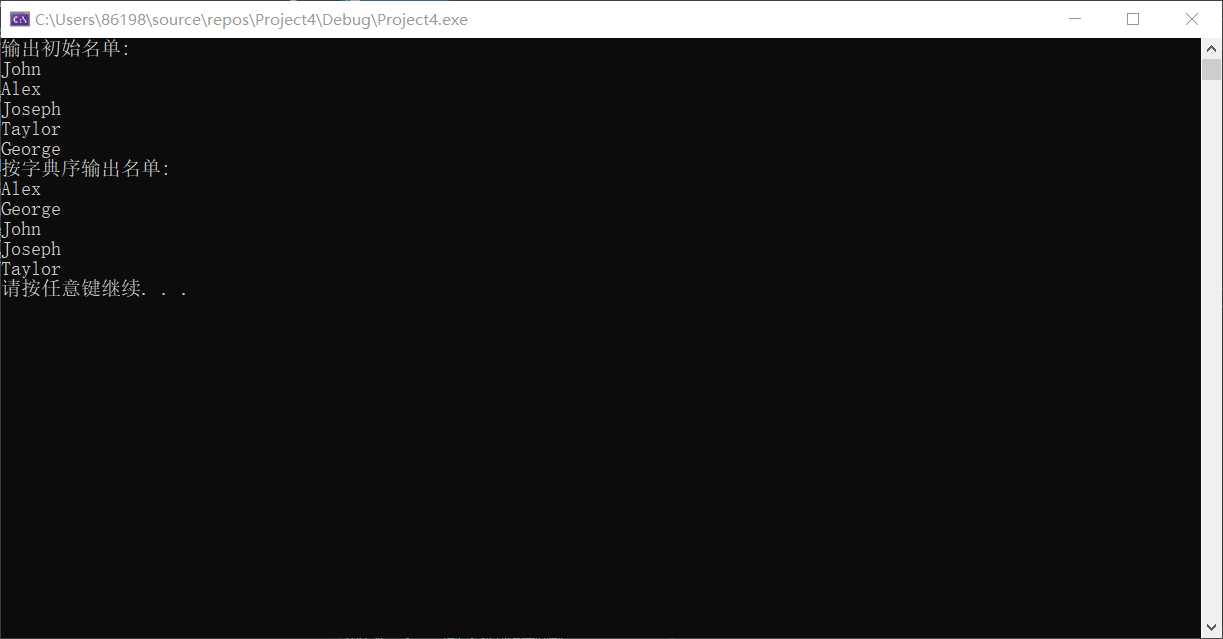
// 示例: 使用选择法排序对一组整数由小到大排序
#include <stdio.h>
#include <stdlib.h>
const int N = 5;
void selectSort(int[], int); // 函数声明(函数声明中可以省略变量名、数组名)
void input(int[], int);
void output(int[], int);
int main() {
int a[N];
printf("输入%d个整数\n", N);
input(a, N);
printf("排序前的数据:\n");
output(a, N);
selectSort(a, N); // 调用selectSort()对数组a中的N个元素排序
printf("排序后的数据:\n");
output(a, N);
system("pause");
return 0;
}
// 函数定义
// 函数功能描述:输入n个整数到数组a中
void input(int a[], int n) {
int i;
for (i = 0; i < n; i++)
scanf("%d", &a[i]);
}
// 函数定义
// 函数功能描述:输出数组a中的n个整数
void output(int a[], int n) {
int i;
for (i = 0; i < n; i++)
printf("%d ", a[i]);
printf("\n");
}
// 函数定义
// 函数功能描述:使用选择法对数组a中的n个整数由小到大排序
void selectSort(int a[], int n) {
int i, j, k, temp;
for (i = 0; i < n - 1; i++) {
k = i; // k用于记录当前最小元素的下标
for (j = i + 1; j < n; j++)
if (a[j] < a[k])
k = j; // 如果a[j]比当前最小元素还要小,就更新k,确保它总是存放最小元素的下标
if (k != i) { // 找到最小元素后,交换a[i]和a[k]
temp = a[i];
a[i] = a[k];
a[k] = temp;
}
}
}
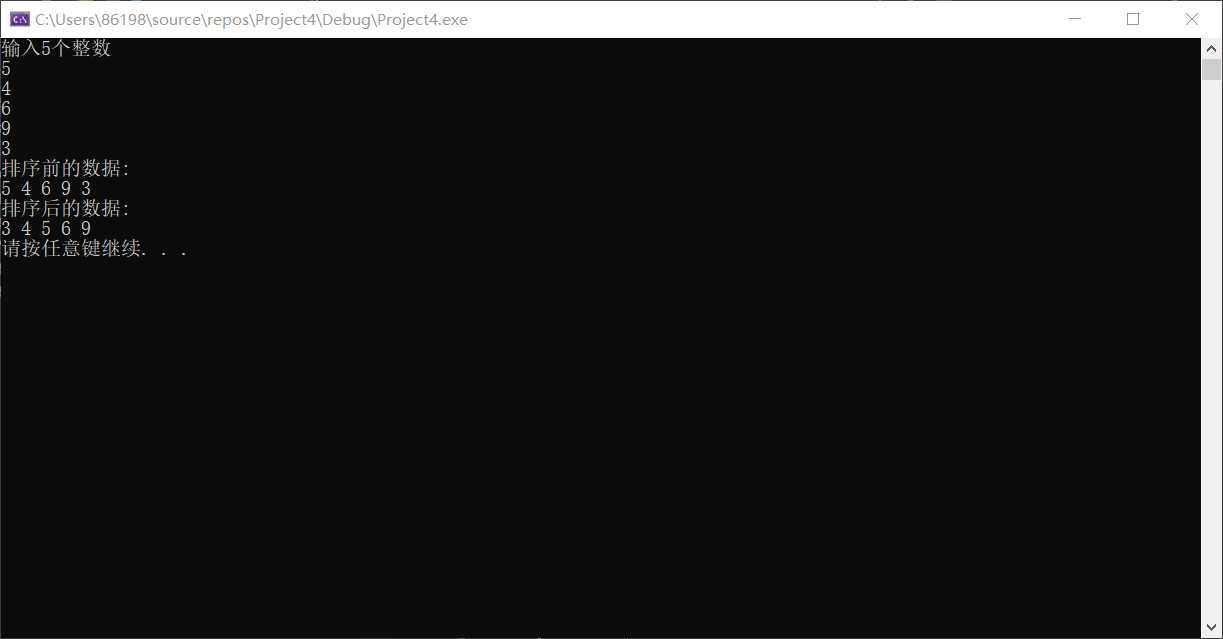
/*
N个字典序的整数已放在一维数组中,给定下列程序中,函数fun的功能是:
利用折半查找算法查找整数m在数组中的位置。
若找到,则返回其下标值;反之,则返回-1
*/
#include <stdio.h>
#include <stdlib.h>
#define N 10
int fun(int* a, int m)
{
int low = 0, high = N - 1, mid;
/*************ERROR**************/
while (low <= high)
{
mid = (low + high) / 2;
/*************ERROR**************/
if (m < * (a + mid))
high = mid - 1;
/*************ERROR**************/
else if (m >= *(a + mid))
low = mid + 1;
else
return(mid);
}
return(-1);
}
int main()
{
int i, a[N] = { -3,4,7,9,13,24,67,89,100,180 }, k, m;
printf("a数组中的数据如下:\n");
for (i = 0; i < N; i++)
printf("%d ", a[i]);
printf("\nEnter m: \n");
scanf("%d", &m);
/*************ERROR**************/
k = fun(a, m);
if (k >= 0)
printf("m=%d,index=%d\n", m, k);
else
printf("Not be found!\n");
system("pause");
}
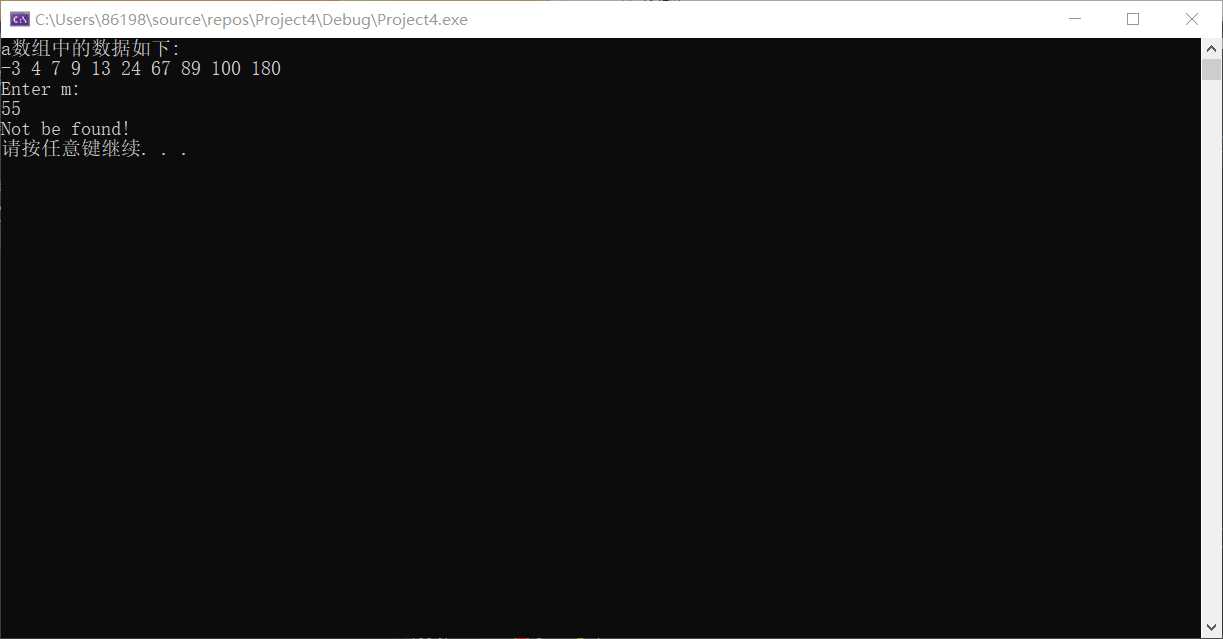
// 练习:使用二分查找,在一组有序元素中查找数据项
// 形参是数组,实参是数组名
#include <stdio.h>
#include <stdlib.h>
const int N = 5;
int binarySearch(int x[], int n, int item); // 函数声明
int main() {
int a[N] = { 2,7,19,45,66 };
int i, index, key;
printf("数组a中的数据:\n");
for (i = 0; i < N; i++)
printf("%d ", a[i]);
printf("\n");
printf("输入待查找的数据项: ");
scanf("%d", &key);
// 调用函数binarySearch()在数组a中查找指定数据项item,并返回查找结果给index
// 补足代码①
index=binarySearch(a,N,key);
if (index >= 0)
printf("%d在数组中,下标为%d\n", key, index);
else
printf("%d不在数组中\n", key);
system("pause");
return 0;
}
//函数功能描述:
//使用二分查找算法在数组x中查找特定值item,数组x大小为n
// 如果找到,返回其下标
// 如果没找到,返回-1
int binarySearch(int x[], int n, int item) {
int low, high, mid;
low = 0;
high = n - 1;
while (low <= high) {
mid = (low + high) / 2;
if (item == x[mid])
return mid;
else if (item<=x[mid])
high = mid - 1;
else
low = mid + 1;
}
return -1;
}
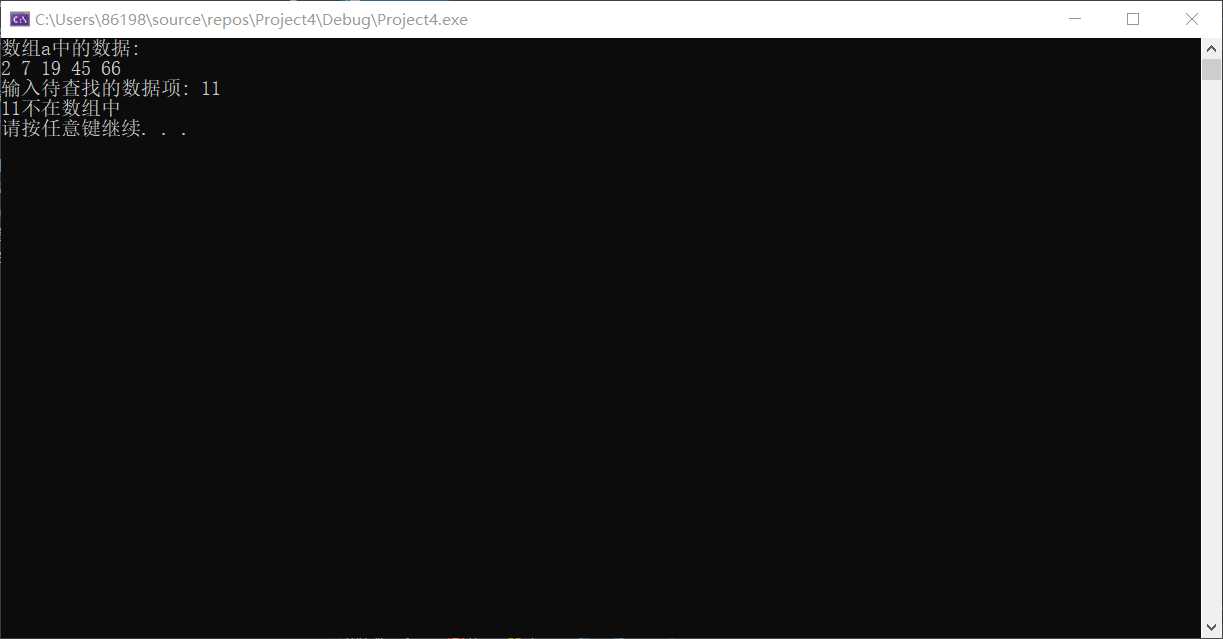
// 这个程序用于观察数组中的一组数据元素在内存中是否是连续存放的
// 以及数组元素的直接访问与间接访问
#include <stdio.h>
#include <stdlib.h>
const int N=3;
int main() {
char a[N] ={‘Y‘,‘E‘,‘S‘}; // 定义一维数组a,包含3个整型数据,并对其初始化,3个元素初始值分别是1,2,3
int i;
// 以"地址:值"的形式打印数组a中每一个数据元素的地址,和数据元素值
printf("通过数组名及下标直接访问数组元素:\n");
for(i=0; i<N; i++)
printf("%d: %c\n", &a[i], a[i]);
// 以"地址:值"的形式打印数组a中每一个数据元素的地址,和数据元素值
printf("通过地址间接访问数组元素:\n");
for(i=0; i<N; i++)
printf("%d: %c\n", a+i, *(a+i));
system("pause");
return 0;
}
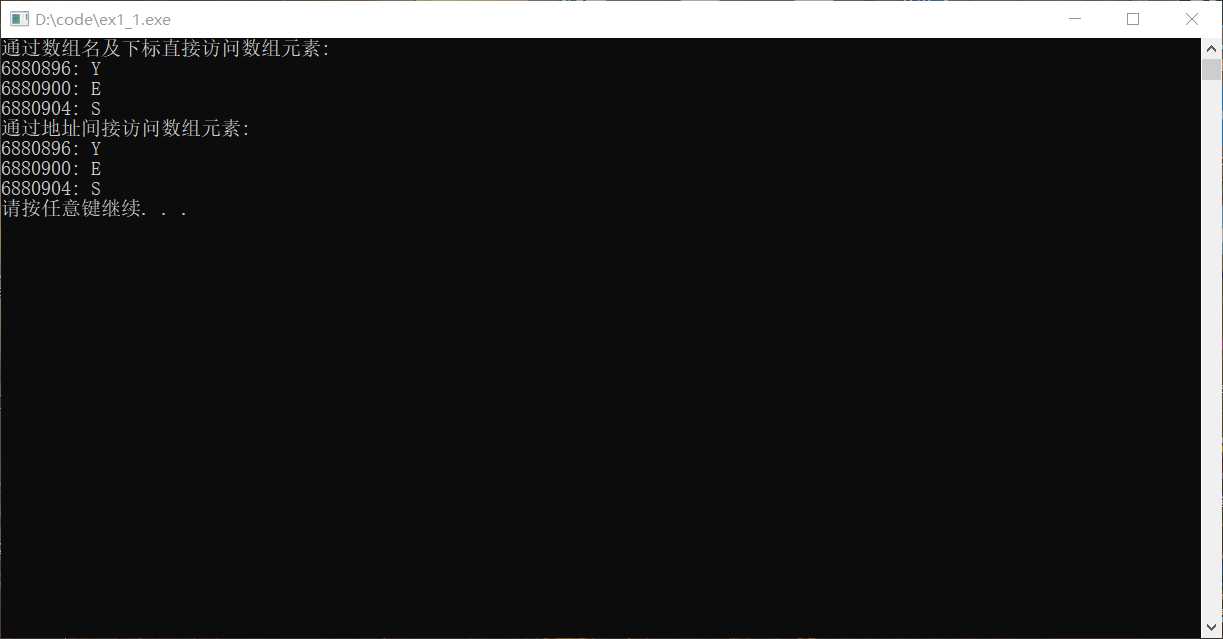
// 这个程序用于观察二维数组在内存中的存放
// 以及二维数组中的地址:元素的地址、行地址
#include <stdio.h>
#include <stdlib.h>
const int LINE=2;
const int COL=3;
int main() {
int a[LINE][COL] = {1,2,3,4,5,6};
int i,j;
// 以"地址:值"的形式打印数组a中每一个数据元素的地址,和数据元素值
printf("通过数组名及下标直接访问数组元素:\n");
for(i=0; i<LINE; i++)
for(j=0; j<COL; j++)
printf("%d: %d\n", &a[i][j], a[i][j]);
// 以"地址:值"的形式打印数组a中每一个数据元素的地址,和数据元素值
printf("通过地址间接访问数组元素:\n");
for(i=0; i<LINE; i++)
for(j=0; j<COL; j++)
printf("%d: %d\n", a[i]+j, *(a[i]+j));
// 观察二维数组中a+i的值,思考其表示的地址
printf("二维地址中a+i表示的地址:\n");
for(i=0; i<LINE; i++)
printf("%d\n", a+i);
system("pause");
return 0;
}
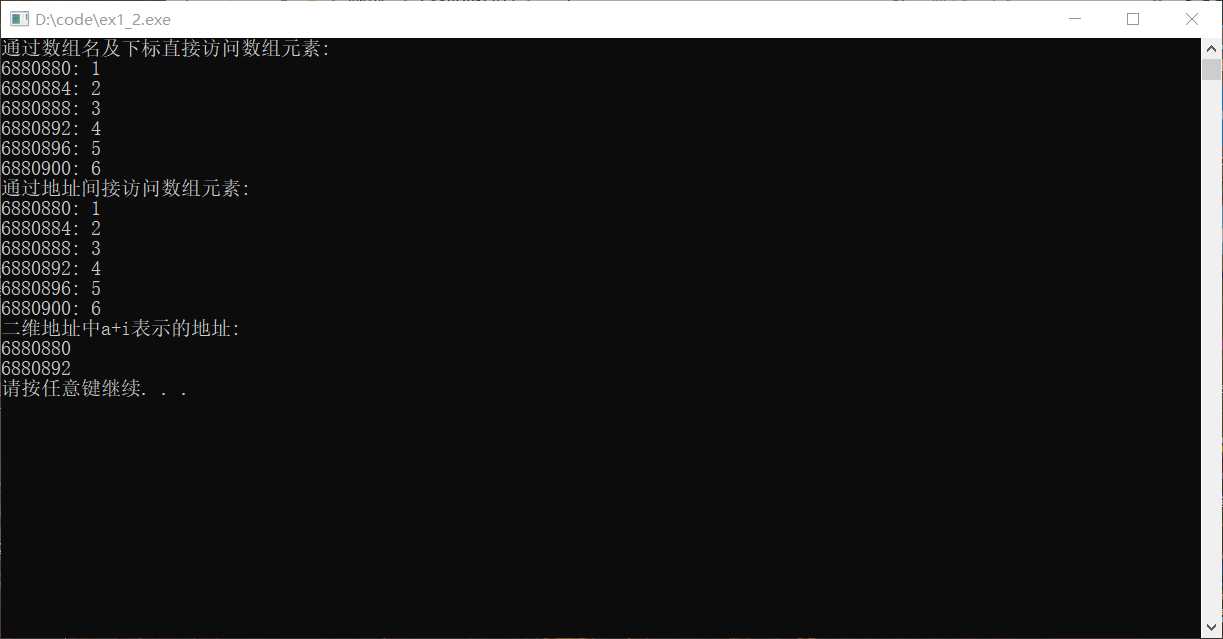
#include <stdio.h>
#include <stdlib.h>
const int N=3;
int main() {
int a[N];
int *p,i;
// 通过指针变量p,完成数组元素输入
for(p=a; p<a+N; p++)
scanf("%d", p);
// 过指针变量p,完成数组元素输出
for(p=a; p<a+N; p++)
printf("%d ", *p);
printf("\n");
p = a;
//通过指针变量p,完成数组元素输入
for(i=0; i<N; i++)
scanf("%d", p+i);
// 通过指针变量p,完成数组元素输出
for(i=0; i<N; i++)
printf("%d ", *(p+i));
printf("\n");
system("pause");
return 0;
}
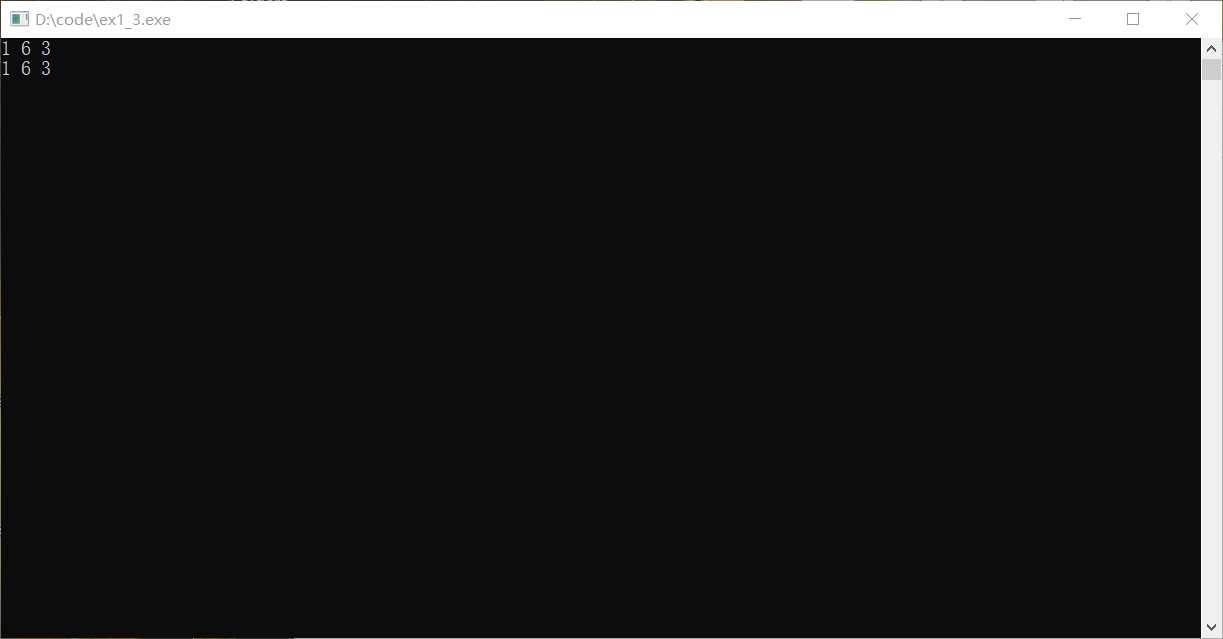
// 使用指针变量间接访问二维数组
#include <stdio.h>
#include <stdlib.h>
int main() {
int a[2][3] = {1,2,3,4,5,6};
int i,j;
int *p; // p是指针变量,存放int型数据的地址
int (*q)[3]; // q是指针变量,存放包含有 3个元素的一维数组的地址
// 通过指针变量p间接访问,输出二维数组a的元素值
for(p=&a[0][0]; p<&a[0][0]+6; p++)
printf("%d ", *p);
printf("\n");
// 通过行指针变量q间接访问,输出二维数组a的元素值
for(q=a; q<a+2; q++)
for(j=0; j<3; j++)
printf("%d ", *(*q+j));
printf("\n");
system("pause");
return 0;
}
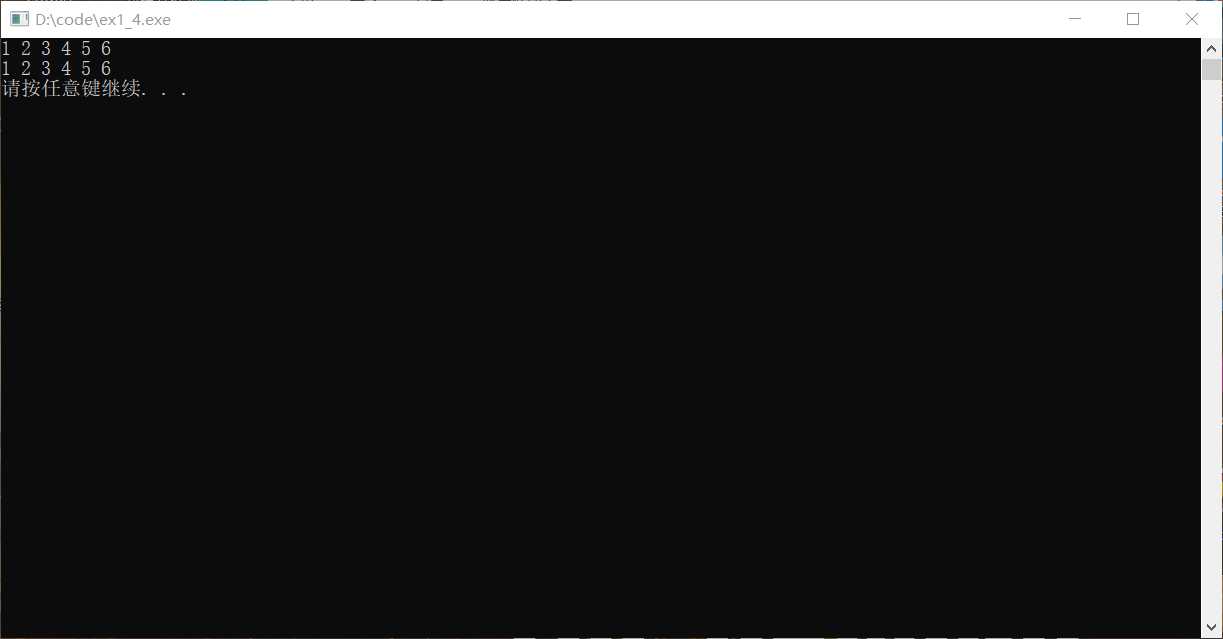
原文:https://www.cnblogs.com/dzp2001/p/12048639.html